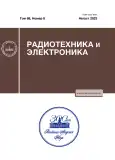Reducing the Energy Consumption of the Transmitting Active Phased Antenna Array of a Low-Orbit Communications Satellite with a “Jumping” Beam
- Authors: Anpilogov V.R.1, Denisenkob V.V.2,3, Levitan B.A.2,3,4, Kozlov V.N.2,4, Shitikov A.M.2,4, Shishlov A.V.2
-
Affiliations:
- JSC VISAT-TEL
- PJSC Radiophysics
- Moscow Aviation Institute (National Research University)
- Moscow Institute of Physics and Technology (National Research University)
- Issue: Vol 68, No 8 (2023)
- Pages: 733-741
- Section: К 100-ЛЕТИЮ Б.В. СЕСТРОРЕЦКОГО
- URL: https://journals.rcsi.science/0033-8494/article/view/138334
- DOI: https://doi.org/10.31857/S0033849423080016
- EDN: https://elibrary.ru/UWVIEW
- ID: 138334
Cite item
Full Text
Abstract
The results of the analysis of the energy consumption of the transmitting active phased antenna array (APAA) of a spacecraft of the low-orbit communication system (with broadband access or with direct access to cellular subscribers) have been presented. It has been shown that in order to reduce energy consumption by switching on (off) the emitters, depending on the beam deflection angle from the nadir, it is possible to achieve a significant reduction in the heat release of the spacecraft’s APAA. But this solution is feasible only if the APAA forms one “jumping” beam.
About the authors
V. R. Anpilogov
JSC VISAT-TEL
Email: shishlov54@mail.ru
Moscow, 123022 Russia
V. V. Denisenkob
PJSC Radiophysics; Moscow Aviation Institute (National Research University)
Email: shishlov54@mail.ru
Moscow, 123363 Russia; Moscow, 125993 Russia
B. A. Levitan
PJSC Radiophysics; Moscow Aviation Institute (National Research University); Moscow Institute of Physics and Technology (National Research University)
Email: shishlov54@mail.ru
Moscow, 123363 Russia; Moscow, 125993 Russia; Dolgoprudny, Moscow oblast, 141701 Russia
V. N. Kozlov
PJSC Radiophysics; Moscow Institute of Physics and Technology (National Research University)
Email: shishlov54@mail.ru
Moscow, 123363 Russia; Dolgoprudny, Moscow oblast, 141701 Russia
A. M. Shitikov
PJSC Radiophysics; Moscow Institute of Physics and Technology (National Research University)
Email: shishlov54@mail.ru
Moscow, 123363 Russia; Dolgoprudny, Moscow oblast, 141701 Russia
A. V. Shishlov
PJSC Radiophysics
Author for correspondence.
Email: shishlov54@mail.ru
Moscow, 123363 Russia
References
- Урличич Ю.М. // Первая миля. 2021. № 3. С. 14.
- Анпилогов В.Р. // Технологии и средства связи. 2013. № 5. С. 66.
- Анпилогов В.Р. // Технологии и средства связи. 2015. № 4. С. 62.
- Анпилогов В.Р., Шишлов А.В., Эйдус А.Г. // Технологии и средства связи. 2015. № 6–2. С. 14.
- Анпилогов В.Р., Денисенко В., Зимин И. и др. // Первая миля. 2019. № 3. С. 16.
- Анпилогов В.Р, Пехтерев С.В., Шишлов А.В. // Технологии и средства связи. 2020. № S1. С. 69.
- Анпилогов В.Р., Пехтерев С., Шишлов А.В. // Технологии и средства связи. Спец. вып. “Спутниковая связь и вещание 2022”. 2021. С. 30.
- Анпилогов В.Р., Денисенко В.В., Левитан Б.А. и др. // Технологии и средства связи. 2022. № 6–2. С. 26.
- Lua W., Lia J, Miaoa J. et al. // Functional Dianond. 2021. V. 1. № 1. P. 189.
- Su Q., Liu J., Xue X., Shi Z. // J. Phys.: Conf. Ser. 2021. V. 2083. P. 1.
- GPP TR 21.917 V17.0.1 (2023-01). 3rd Generation Partnership Project; Technical Specification Group Services and System Aspects; Release 17 Description; Summary of Rel-17 Work Items (Release 17). Valbonne: 3GPP Organizational Partners. 2022.
- FCC Report. Database Report/Search Tool for FCC Information. https://fcc.report/IBFS/SAT-LOA-20210511-00064.
- Rec. ITU-R SF.1482. Maximum allowable values of power flux-density (pfd) produced at the Earth’s surface by non-GSO satellites in the FSS operating in the 10.7–12.75 GHz band. Geneva: ITU, 2000.
- Анпилогов В.Р., Афонин A.A. // Электросвязь. 2011. № 7. С. 45.
- Шишлов А. В., Левитан Б. А., Топчиев С.А. и др. // Журн. радиоэлектроники. 2018. № 7. С. 1.
Supplementary files















